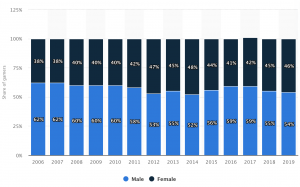Difference between revisions of "Gender in Video Games"
| Line 22: | Line 22: | ||
https://kotaku.com/shigeru-miyamoto-and-the-damsel-in-distress-520259897 | https://kotaku.com/shigeru-miyamoto-and-the-damsel-in-distress-520259897 | ||
| + | |||
| + | [[Category:2020New]] | ||
| + | [[Category:2020Concept]] | ||
Revision as of 13:59, 17 March 2020
Gender in Video Games refers to the representation of different genders as they are portrayed in characters created for the video gaming medium. While gaming as both a medium and culture has changed drastically over its history, the content that it contains has evolved to accommodate not only new technologies as they are invented, but also the social environment of the times in order to better cater to its intended audiences. In many cases, given the escapist nature of many video games throughout history and their ability to allow players to live fantastical lives outside of their own, this can mean that the characters that players use - often as avatars to act out these fantasies - can be caricatures or stereotypes of people that exist at the time these games were published. While game designers are often looking to real world examples to further flesh out the content of their games, and the intended social consequences of their work is benign, the prevalence of the medium dictates that regardless of intention they have unintended consequences. These include the ways in which people see themselves who are from the societal, economical, racial, and gendered demographics that are represented by these images. While all depictions that negatively affect the image of those disparaged should not be overlooked, the most hotly contested representations in our culture today derive from those of gender.
Overview of Player Base
While video gaming as a medium is quite young in comparison to other popular forms of entertainment such as books and magazines, and even in comparison to other forms of pop culture such as music, comic books, and film, it is hard to understate its impact on culture today. In 2018, nearly 2.7 billion people worldwide played video games, and those who identified as gamers accounted for 66% of the US population alone. While the medium has traditionally been seen as having a player base that largely identifies as male, today in the U.S.
The difference is much closer to a 50/50 split, as in 2019 it was reported that 46% of the population claiming to be part of the gaming community identified as female. With the player base being so close to an even split today, the market has been slowly shifting course to express views that are more in line with those of the culture and its views on gender today, but it is important to understand the history of gaming and how it has shaped its characterization of gender in the years and decades prior.
History
The history of video gaming itself spans nearly 50 years when home consoles such as the Magnavox Odyssey were released back in the early 70's, but the true heyday of gaming didn't start until the release of the Famicom in Japan, and the Nintendo Entertainment System (NES) to the US and the rest of the world in 1983. While gaming was originally marketed as a family activity for children and adults of all genders and ages alike, after the video game crash of 1983 Nintendo's new home console was marketed primarily toward boys as the gendered marketing tactics of the 80's forced the company to choose an audience to cater its marketing toward. Subsequent consoles of the era followed suit and soon video gaming was seen as a hobby for boys.
The representation of female characters in gaming started off mostly as those who would be saved by a male protagonist as in these early days of gaming. Large cabinets were needed to produce improved graphics over those of the home consoles, and arcades were the dominant place to gather and enjoy these benefits. Since many gamers who would go to enjoy their pastime were much more often men and boys than women, this affected the representation of gender in the games themselves. As a pioneer of the medium and still active creator Shigeru Miyamoto states in an interview with Kotaku regarding the development of the 1981 game Donkey Kong : "back in the days when we made the first Donkey Kong, that was a game we first made for the arcades, the arcades were not places girls went into often. And so we didn't even consider making a character that would be playable for girls."
While this would remain true for many years to come, the rumblings of diversity and gender representation through gaming would begin in this new console form for the medium. In 1986's hit title Metroid for the NES it would be revealed to the player, upon completing the game in a specified amount of time, that the strong, defiant, lone-wolf hero character they had been playing throughout the adventure was in fact a woman in a suit of armor. While this was a shock to many players, it by no means shifted the video gaming culture at large, and in fact much of the gender based controversy in gaming to come would take place in the decades to follow. The reveal of Samus Aran would, however, serve as one of the first instances of a strong female protagonist in video gaming, and through much of the following controversies and even the growing number of characters in gaming, Samus Aran remains one of the most popular and respected characters in video games to this day.
References
https://www.statista.com/statistics/232383/gender-split-of-us-computer-and-video-gamers/
https://www.statista.com/topics/3070/us-gamers/
https://kotaku.com/shigeru-miyamoto-and-the-damsel-in-distress-520259897


